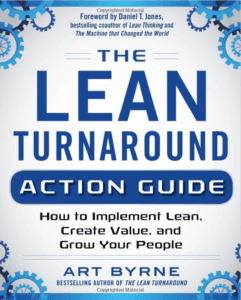Today's Post in <50 Words: Art Byrne's latest book, The Lean Turnaround Action Guide, has a lot of great tips that he's trying to share, CEO to CEO. How many CEOs are reading this book and heeding his advice, in manufacturing or in healthcare?
I've been reading Art Byrne's latest book, The Lean Turnaround Action Guide: How to Implement Lean, Create Value and Grow Your People.
Art was, of course, the CEO of the company Wiremold and he drove their Lean transformation and the business success that resulted.
When his earlier book The Lean Turnaround was released, I interviewed him for my podcast:
And I will be interviewing him soon about this latest book.
As Dan Jones says in the intro to the book, CEOs tend to listen to other CEOs.
Hear Mark read this post (subscribe to the podcast):
Will hospital CEOs listen to Art and his advice? I think they should. Are they reading this book? Probably not?
Here are some highlights and key insights from the first few chapters of Art's latest book:

How many hospitals view Lean as “the strategy” as opposed to viewing Lean as a set of tools or a series of projects?
In the book, Art is speaking to the leadership team at a manufacturing company, but also says, at one point, that the ideas apply to hospitals as well (as he knows from the Virginia Mason Medical Center story and the role he and Wiremold played in helping VMMC).
How many hospital CEOs are leading this Lean journey “from the top” as opposed to delegating it to a director? Some CEOs like John Toussaint, Gary Kaplan, Eric Dickson, and the late Michel Tétrault have done that… and the results show.
How many healthcare organizations are working to “transform the people” (at all levels) by engaging them in improvement (as they do so well at Franciscan St. Francis Health – come and see).
The phrase “transform the people” sounds vaguely threatening, unless the CEO goes first and leads by example. How many hospital CEOs are doing that as opposed to pointing fingers at everybody else who needs to change?
Note that Art says you “must do” these things – they aren't optional, in his view. I'd tend to agree.
Here is Art's summary from Chapter 1:

Is Lean viewed as an “operations thing” in your hospital or a core part of the strategy?
Are your leaders, including the CEO, learning by doing by participating directly in improvements, large or small?
Is your organization removing waste for the benefit of customers or just implementing tools and copying “Lean management” bulletin boards that you saw at ThedaCare?
Art, in the book, addresses the idea that Lean is a great way to protect the workforce instead of “cutting heads.”

I've written similar things here and shared examples from hospital CEOs that “get it”:
We have to help our people grow (engaging them in Kaizen improvement is a great way to do that) instead of just viewing them as a cost to cut.
What do you see happening out there? How do we get hospital CEOs to listen to great business leaders like Art?
Disclosure: I was given a free review copy by the publisher.
What do you think? Please scroll down (or click) to post a comment. Or please share the post with your thoughts on LinkedIn – and follow me or connect with me there.
Did you like this post? Make sure you don't miss a post or podcast — Subscribe to get notified about posts via email daily or weekly.
Check out my latest book, The Mistakes That Make Us: Cultivating a Culture of Learning and Innovation:











Mark:
The “CEO to CEO” method is the approach we use in our hospital. We identify physicians (or they identify themselves) who are demonstrably outgoing about engaging in improving the work environment (e.g., removing non-value added steps in a process) for their benefit but more importantly, for the benefit of our patients. The “seed” physicians help inform and energize other physicians who may be on the fence about Lean (or outright skeptics). We are slowly gaining more traction across the organization as we try to create an environment where Lean thinking becomes part of the organization’s culture. It’s definitely not easy, but the demonstrated successes of other healthcare institutions should serve as a highly visible reminder of the value of engaging in Lean thinking–it’s the right thing to do.
That’s great. Thanks for sharing that. Peer-to-peer, including physician-to-physician seems like a great strategy for getting people interested and spreading Lean knowledge… and helping people want to take action.
One of my favorite ways to gauge the stickiness of Lean in an organization is to ask them who owns Lean (or OpEx, PEX, etc) in their hospital. The greater the number of degrees of separation between that person and the CEO goes a long way towards informing how much of a priority they’re making it.
I took a hospital leadership team to Denver Health a few years ago. Nothing demonstrates Lean culture like the CEO, COO, and physician leadership each spending an hour talking to complete strangers about their lean journey.